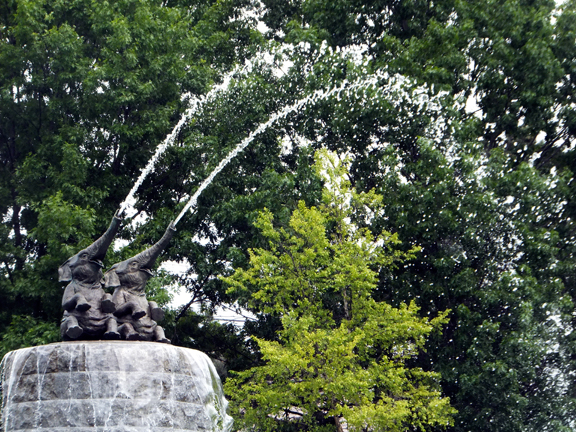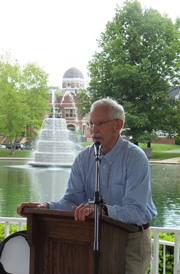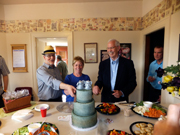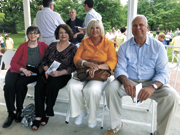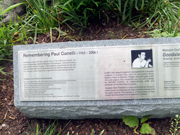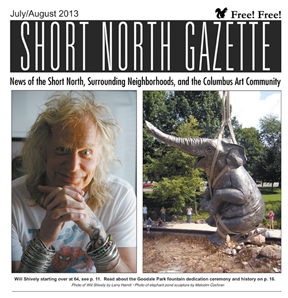
Columbus, Ohio USA
Return to Homepage www.shortnorth.com
Sink or Swim
Goodale Park fountain finally makes a splash
after years of labor and love
By Cynthia Bent Findlay
July/August 2013 Issue
Return to Homepage
Return to Features Index
Photos © Gus Brunsman III
Two bronze elephants create a fanciful water feature in Goodale Park reflecting the Sells Circus history in Columbus. On May 19, a ceremony beside Goodale Park’s lake celebrated a long, long awaited dedication. The towering granite fountain topped with two bronze elephants that arose from the lake began streaming water last fall, but the ceremony had been postponed until the warm spring weather.
It was a fitting delay, the capper to a project which took 11 years from conception to successful completion. But finally, Stan Sells, chair of the Friends of Goodale Park committee tasked with creating the fountain, was able to formally celebrate along with the Friends, representatives of the city, and scores of others who made the fountain possible.
“Phew,” those who frequent the park will doubtless think. The park’s lake was empty or only partially filled for nearly 18 months beginning in late 2010. Fishermen and wedding parties booking the nearby gazebo despaired.
But probably few know how arduous a task raising the fountain has been. More than a decade of work and wait has gone into raising the granite tiered pedestal. The fountain’s existence is truly a tribute to the perseverance and dedication of the neighborhood. Its story also echoes the park’s own in a lot of ways.
The Friends of Goodale Park, the group of volunteers which led the charge for the new fountain, belongs to a long tradition of park protectors. Throughout the 160-year history of the park, neighbors have banded together to create the water features, install lighting, plant trees, plan its use and nurture its landscape.
Prominent Columbus physician Dr. Lincoln Goodale gave the land for the park to the city in 1851 for $1, provided that it would be forever preserved as a park, and a park it has stayed, despite housing Civil War troops and falling into decline from time to time.
A fountain first appeared in Goodale Park on the southwest corner of the park in 1872, in the opposite corner of the present lake, near Goodale and Dennison. The same summer, plans were made for the lake, dubbed East Lake, and a boathouse was constructed. The lake itself took three years to complete due to lack of funds, but park proponents dug in, so to speak, and the lake has been around ever since.
The park was a celebrated urban haven even before then, a spot for leisurely carriage rides around the circumference and ice skating parties in the winter. It was a playfield for generations of city kids, often children of the immigrant workers of Flytown, which bordered the southern end of the park. The lakes – for there was another for a time on the western edge of the park – were even a place for cooling off – one account noted women and children scandalously hitching their skirts and wading in on a hot afternoon.
In the late 1980s a group of area residents banded together to raise funds to replace trees lost in a summer storm. The group called themselves the Friends of Goodale Park. Over time, as FGP sought improvements in the park such as lighting and benches, the organization forged a strong relationship with the Columbus Recreation and Parks Department and became the neighborhood voice representing Goodale Park. FGP has since planted hundreds of trees and led the way for $3 million in park improvements including a new gazebo, expansion of the shelter house, redesign of the playground, restoration of the 1870 Goodale gates and the 1899 Fish Gate, the installation of a new pedestrian entrance at Park and Goodale, park lighting and benches – and the new fountain.
By 2002, the FGP became committed to creating a new water feature in the lake. A bubbling rock cairn, a Works Progress Administration project, had been in place between 1933 and 1995, when it finally crumbled and was removed. Though many felt the old fountain had been less than beautiful, says Stan Sells, a longtime neighborhood booster, its lack was felt.
“The board [of the FGP] decided the park needed a water feature and it needed to be significant, and then decided it ought to be piece of artwork as well,” says Stan Sells.
Initially, the thought was that the FGP would raise and spend around $100,000 on the project. Little did he anticipate, Sells says, the journey on which he was about to embark.
1. Stan Sells 2. Elephant fountain cake made by Piece of Cake. (L) Malcolm Cochran, Maddy Weisz and Stan Sells. 3. (LtoR) Carol Stults, Dagmar Cianelli with Paul Cianelli's mother, Sandra Wilkinson, and stepfather Chuck Wilkinson (far right) at fountain dedication.
4. Plaque remembering Paul Cianelli (1963-2006) who helped spearhead the campaign.
5. Pet store retailers Jo Johnson and Susan Oilar 6. Prepared for the pet parade.The FGP began fundraising and set up competition to find an artist for the fountain. The charge was to create a fountain to appeal to the park’s diverse audience. The FGP also wanted a fountain that would be able to operate year-round, as many remembered the interesting ice formations that resulted each winter from the former fountain.
The call went out around the world, and 54 artists from as far away as Japan submitted entries. After rounds of initial screening, public review and comment, Malcolm Cochran, an Ohio State University art professor and local sculptor, was selected to design the fountain.
Cochran has created numerous prominent public art projects around the country, including works in Vermont, Atlanta, Hudson River Park in New York and more. He’s also the creator of Dublin’s famous two-acre Field of Corn. His proposal for a serpentine-shaped tower to be titled Tête à Tête was initially projected to cost something around $200,000. Fundraising began in earnest, Sells says.
But $200,000 turned out to be a gross underestimation. Engineering estimates to fabricate the work came in at around $500,000.
Slightly daunted but still determined, Sells and his committee worked hard to raise the money. They did raise a couple of hundred thousand – no mean feat for a small and very local volunteer group.
One particular group, the friends and family of Paul Cianelli, raised roughly $60,000 toward the project. Cianelli, an architect, a trustee of the Friends of Goodale Park and a tireless volunteer with many other neighborhood groups and campaigns, passed away in 2006. Cianelli helped to spearhead the campaign to launch the fountain design competition back in 2002. The fountain now bears a plaque in his honor.
But, by 2008, Sells says, they were still far short. And then came the Great Recession, and with it, says Sells, serious concerns about the ability to raise the total amount.
“I’d wake up at night with cold sweats thinking about how to raise the rest of that money. Finally, we had to go back to Malcolm and ask if he’d be willing to come up with different design to get us into a different ballpark,” says Sells.
“I said then, we could put Tête à Tête on, shrink it to bring it into budget, but it would be like saying let’s build a Victorian, but only a one-story. It would be better to do a really beautiful ranch than squeeze it into tiny Victorian. So I wanted to go back to the drawing board and come up with new ideas,” says Cochran.
Cochran says he and the steering committee held on to a few elements – that granite be the most predominant material, that it would continue to operate year round, and be viewable from many angles. On reading up on the history of the area, Cochran was struck by the story of the Peter Sells house, an attention-grabbing “tent” house at the corner of Park and Dennison that was built by Peter, one of three brothers who had formed the Sells Circus in the late 1800s.
And that is how elephants came into play, Cochran says. The circus was well-known for its elephants and housed them just across the river in Sellsville, the winter headquarters for the circus.
Although the elephant tower is scaled down from what Tête à Tête would have been, it’s certainly not petite. There are 555 pieces of Indian granite secured to each other by multiple steel pins. The center is filled with concrete. The total weight of the fountain: 750,000 pounds. It circulates 550 gallons of water per minute.
So, for something just under $300,000, Cochran’s design of the elephants atop what has been called a granite wedding cake finally was adopted in the spring of 2009. The elephants were to be cast of bronze, the granite to be shipped from India.
Columbus Art Memorial took the lead on the granite construction, working with a Los Angeles firm for the fountain’s more technical water-moving parts. It was hoped that the city would have the pond drained so construction could begin in the fall of 2010, but that operation was delayed long enough that it was the spring of 2011 before they would be able to get to work.
As luck would have it, the spring of 2011 was the wettest spring in Columbus’ history and construction was delayed until the foundation could be installed in the pond.
“They drained an additional 1.5 million gallons from the pond. I tried to explain to people, it was like building a structure in the bottom of a bathtub with the shower running,” says Carmen Menduni president of Columbus Art Memorial.
Construction took the better part of the summer. By the fall of 2011, the elephants sat atop their granite perch, and the city began to fill the pond. By this time, however, the spring’s floods reversed their course and perversely, the pond refused to hold water. Several studies were done. A special clay surface which expands when it absorbs water was installed around the fountain, but water continued to drain.
More bentonite clay was applied to the entire pond, and the walls of the pond were sealed. Still, the water seeped away, all through the end of the year and into the spring of 2012.
Next, a special waterproof membrane was installed all around the fountain, secured with a stainless steel strap at the base of the statue, and buried in the bentonite at the bottom edge. The pond finally held water… until last summer’s vexingly hot, dry streak hit.
Water evaporated into the blazing skies faster than the well pump which fed the pond could replenish it. The city then paid for a larger pump, doubling the water volume output to the pond, and finally, finally, last fall, the elephants were free to spout. The fountain was turned on full-time as of September 14, 2012.
The fountain has been working well this past winter, Sells says. Just as the FGP had hoped, gorgeous ice formations dripped down the granite on frigid days. This spring, the long-awaited dedication ceremony was finally planned and successfully held.
The day kicked off with a dog parade and costume competition. Speakers had their moment – Stan Sells enlightened the 200-some people in attendance about the history of the efforts to raise the fountain, local realtor Bruce Dooley spoke about his friend Paul Cianelli and his lifetime of helping the neighborhood, Malcolm Cochran talked about his inspirations for the fountain’s design.
FGP President Jason Kentner then officially gifted the fountain to the people of Columbus, represented by Alan McKnight, Director of the Columbus Recreation and Parks Department.
The ceremony moved to the plaque dedicating the fountain to Cianelli, and then on to a reception featuring a brilliant replica cake of the fountain by Short North bakery Piece of Cake.
After the pain of giving birth to two different designs and ten years’ worth of fundraising, Stan Sells says it has all been worth it.
“I would have to say I think we ended up with a more satisfying design from the standpoint of a number of historical contexts for the park, and it’s really seemed to generate a lot of positive response from the community,” he says. “It’s been quite a ride.”
Visit www.goodalepark.org
© 2013 Short North Gazette, Columbus, Ohio. All rights reserved.
Return to Homepage www.shortnorth.com
